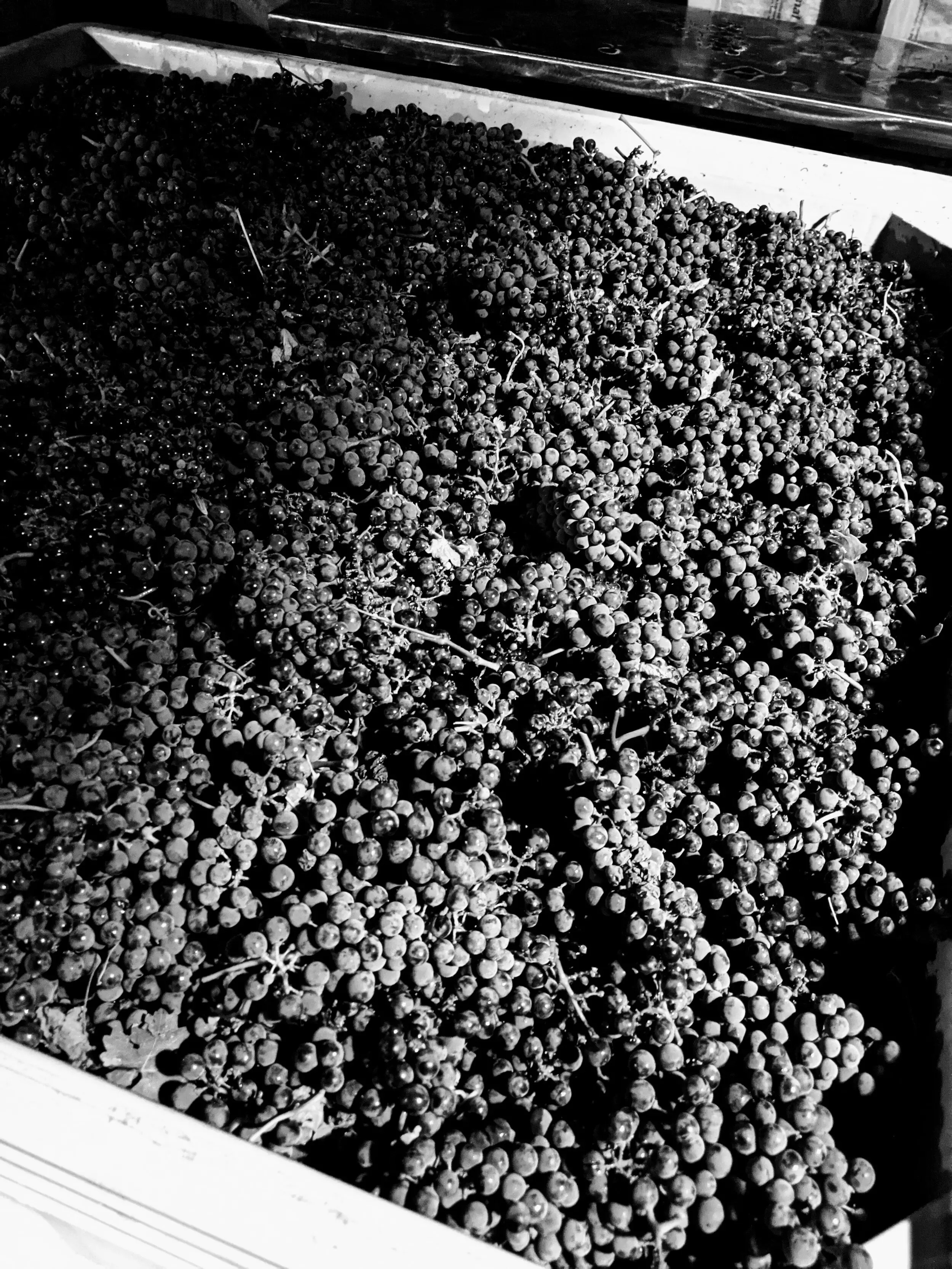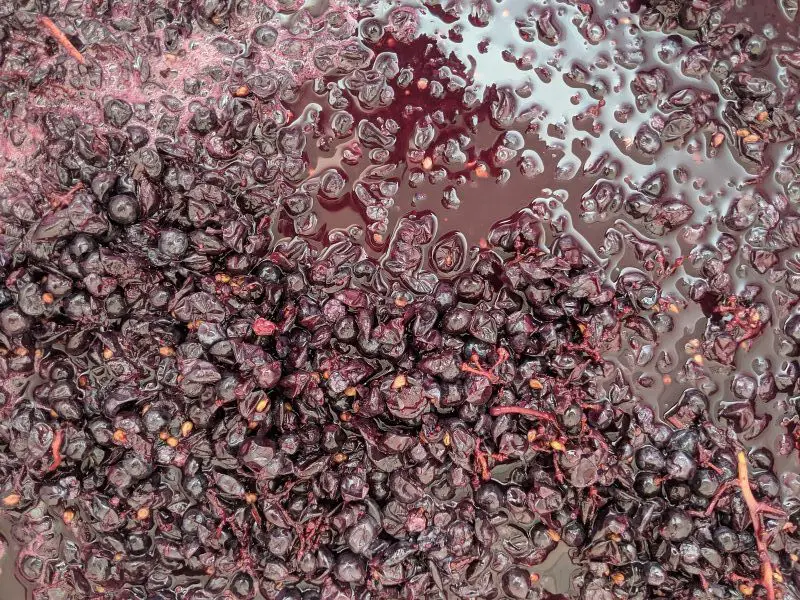Harvest day is the culmination of an entire year’s worth of work and anticipation for wine grapes. It’s a busy day for the winemaker.
What happens on harvest day for red wine grapes? The harvest date depends on labor or machine availability. Wineries are responsible for arranging grape transportation. Grapes may or may not be sorted depending on the wine’s price point. The grapes are crushed, destemmed, and transferred to a fermentation vessel. The winemaker decides to set aside the must for several days to enhance the ‘red’ color in the final wine. Fermentation typically doesn’t begin until the day after harvest.
Here’s what you need to know about harvest day.
What Happens to Red Grapes on Harvest Day?

Drive through wine country early in the morning mid-fall, and the air buzzes with activity. Huge trucks hauling gondolas of grapes to the local sugar shacks for testing fill the streets. Rows of fieldworkers move through the vineyards deftly culling the crop.
Back at the winery, forklift operators navigate bins of grapes arriving on the winery crush pad, tackling the seemingly endless job of grape processing.
Here’s a glimpse of the day a red grape gets harvested.
How Do they Set the Harvest Date?
The winemaker and vineyard owner set the harvest date in advance. They decide on the date based on a few factors.
First, the grapes need to be ripe. The vineyard manager and winemaker will test the grapes’ sugar and pH throughout the season, more frequently in the weeks and days leading up to harvest.
Once they have a good sense that the grapes are entering a window of peak ripeness, the grower needs to arrange labor to bring in the harvest.
This could be a picking crew or even a skilled driver for a mechanical harvester. If using a picking crew, the vineyard owner negotiates with the head of the crew to find a date that works around the crew’s schedule.
These crews will travel around to different vineyards during harvest, all of which will have grape crops ripening around the same time.
Wineries processing several different varieties of grapes, or doing custom crush for outside clients, need to coordinate grape arrival dates and times so that they have the space and labor available for processing.
Picking the Red Wine Grapes

The physical act of harvesting, whether by hand or machine, ends with grapes in bins. These may be huge gondolas carried behind trucks, or white macro bins, or even 50 lb. lug crates.
The smaller the container, the gentler the grape’s transportation to the winery.
Harvesting happens at night or early in the morning when the grapes are cool to decrease oxidation during pick and transport.
It’s also better for field laborers working in hot conditions (California has labor laws for fieldhands and extreme temperatures).
Transporting the Red Wine Grapes to the Winery

The winery arranges to haul the grapes back to their processing facilities. At this point, the winemaker will pour them directly into a crusher and destemmer, or use a sorting table with a conveyor belt to sort through the grapes and remove unwanted debris.
Why do they need to sort through the grapes before processing?
Green grapes, grapes with fungal rot, damaged grapes, leaves, small dead critters that get caught in harvesters or netting – all this and more can end up in the harvest bins.
Jargon Alert: Material other than grapes (MOG for short), is a catch-all term to describe unwanted debris that gets caught up in the harvest. MOG decreases the overall quality of the final wine.
An inexpensive, mass-market wine likely won’t go through the sorting step because of the increased production costs for razor-thin margins. Super-premium wines, like Burgundy Grand Cru and Napa Cult Cabernets, demand this attention to detail. The no-expense-spared is part of the luxury branding technique.
Careful hand harvesting reduces the need for sorting, but winemakers may still opt to sort for leaves or diseased grapes that could be hard to see when harvesting at night.
After sorting (or not), the grapes move by conveyor belt or auger to the crusher destemmer.
Crushing and Destemming the Red Wine Grapes
The grape crusher destemmer first gently squeezes the grape, breaking its skin enough to release the juice for fermentation and to allow the yeast inside.
The grapes pass through these rollers into a holed chamber below that separates the stems from the grapes. The machine catches the stems and shoots them out while allowing the juice, grapes, and seeds to pass through the holes into a reservoir.
What Is Wine Must?

At this point, the juice, skins, and seeds are considered ‘must’. The must gets pumped from the reservoir into a fermentation vessel.
Depending on the intended style, this can be a barrel, stainless steel tank, cement, or even clay amphora – whatever the winery uses.
Getting the Wine Started
The winemaker now has a vessel filled with must and is ready to start the process.
But not quite yet!
The winery lab runs a series of tests to determine the must’s pH, titratable acidity, sugar, and nitrogen levels. These are the starting points that will help the winemaker monitor the fermentation process over the next several days or even weeks.
If there are imbalances in any of the lab tests, this is the best time to make adjustments.
Additions or corrections before fermentation have the opportunity to fully integrate into the final wine.
When Do You Add Wine Yeast to Red Wine?
Deciding when to add wine yeast depends on the final wine style.
Some red grapes, like Pinot Noir and Nebbiolo, are thin-skinned, so much so that the winemaker may opt to move the must into a cold room and keep it there for several days to let the skin pigmentation, or anthocyanins, leech into the juice. This decision, called cold soaking, could be the difference between a Pinot Noir that looks like a rosé and a Pinot Noir that looks like a red wine.
Another factor is whether the winemaker wants to use natural fermentation or commercial yeast.
If the winemaker decides to try to ferment using ambient yeast, then the day’s processing is complete and the vessel gets set aside for monitoring
By far, though, most winemakers use commercial yeast strains.
In this case, the winemaker douses the must with sulfites, or SO2, to kill any wild yeast strains and sets the must aside for 24 hours. One day later, they add the commercial yeast, and fermentation begins.
And thus completes the red grape’s epic journey from field to the winery on harvest day
Thirsty for More?
Check out this post that explains how wine fermentation works.
Here’s a list of all of the different choices a winemaker has for fermentation vessels.




